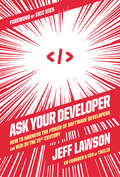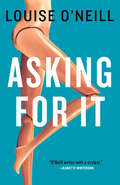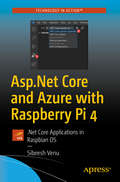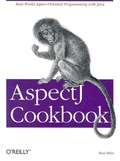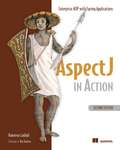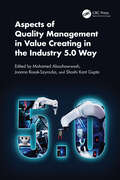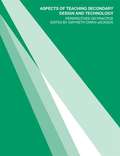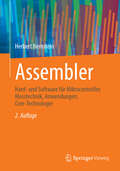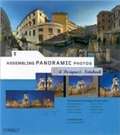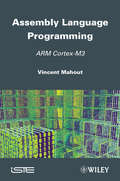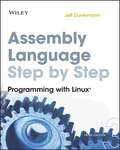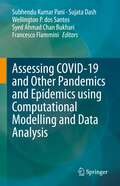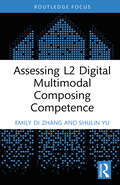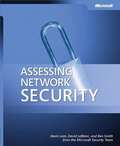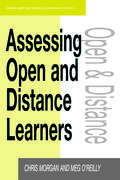- Table View
- List View
Ask Your Developer: How to Harness the Power of Software Developers and Win in the 21st Century
by Jeff LawsonJeff Lawson, software developer turned CEO of Twilio, creates a new playbook for unleashing the full potential of software developers in any organization, showing how to help management utilize this coveted and valuable workforce to enable growth, solve a wide range of business problems and drive digital transformation.From banking and retail to insurance and finance, every industry is turning digital, and every company needs the best software to win the hearts and minds of customers. The landscape has shifted from the classic build vs. buy question, to one of build vs. die. Companies have to get this right to survive. But how do they make this transition?Software developers are sought after, highly paid, and desperately needed to compete in the modern, digital economy. Yet most companies treat them like digital factory workers without really understanding how to unleash their full potential. Lawson argues that developers are the creative workforce who can solve major business problems and create hit products for customers—not just grind through rote tasks. From Google and Amazon, to one-person online software companies—companies that bring software developers in as partners are winning. Lawson shows how leaders who build industry changing software products consistently do three things well. First, they understand why software developers matter more than ever. Second, they understand developers and know how to motivate them. And third, they invest in their developers' success. As a software developer and public company CEO, Lawson uses his unique position to bridge the language and tools executives use with the unique culture of high performing, creative software developers. Ask Your Developer is a toolkit to help business leaders, product managers, technical leaders, software developers, and executives achieve their common goal—building great digital products and experiences. How to compete in the digital economy? In short: Ask Your Developer.
Asking For It
by Louise O'NeillEmma O'Donovan is eighteen, beautiful, and fearless. It's the beginning of summer in a quiet Irish town and tonight she and her friends have dressed to impress. Everyone is at the party, and all eyes are on Emma. The next morning Emma's parents discover her collapsed on the doorstop of their home, unconscious. She is disheveled, bleeding, and disoriented, looking as if she had been dumped there.To her distress, Emma can't remember what happened the night before. All she knows is that none of her friends will respond to her texts. At school, people turn away from her and whisper under their breath. Her mind may be a blank as far as the events of the previous evening, but someone has posted photos of it on Facebook under a fake account, "Easy Emma"--photos she will never be able to forget.As the photos go viral and a criminal investigation is launched, the community is thrown into tumult. The media descends, neighbors chose sides, and people from all over the world want to talk about her story. Everyone has something to say about Emma. Asking For It is a powerful story about the devastating effects of rape and public shaming, told through the awful experience of a young woman whose life is changed forever by an act of violence.
Asp.Net Core and Azure with Raspberry Pi 4: .Net Core Applications in Raspbian OS
by Sibeesh VenuGet to know your Raspberry Pi. Then take it further with Microsoft Azure resources and this book. We live in a world everything is connected. The future is leaning towards IoT. Running the Raspberry PI with .Net core applications opens a world of possibilities. What if we add the power of Microsoft Azure to it? In this book, you'll learn how to set up your Raspberry PI with .Net core and analyze the options Microsoft offers in Azure. Once the initial set up is complete, you'll move on to a real-world scenario—running your own application inside a Raspberry PI. The book then explains how to develop an application that sends automated data to the Microsoft Azure IoT hub and how to retrieve and send the data to your Azure SignalR service with the help of Azure Function. What You'll Learn Set up Raspbian OS on the Raspberry Pi for use with Microsoft Azure Develop a .Net core background application Connect Azure resources to your application Who This Book Is For Programmers with a background in coding—especially knowledge in JavaScript, Angular, and C#. Working familiarity with Azure flow is helpful.
Aspect-Oriented, Model-Driven Software Product Lines
by Awais Rashid Andreas Rummler Jean-Claude RoyerSoftware product lines provide a systematic means of managing variability in a suite of products. They have many benefits but there are three major barriers that can prevent them from reaching their full potential. First, there is the challenge of scale: a large number of variants may exist in a product line context and the number of interrelationships and dependencies can rise exponentially. Second, variations tend to be systemic by nature in that they affect the whole architecture of the software product line. Third, software product lines often serve different business contexts, each with its own intricacies and complexities. The AMPLE (http://www.ample-project.net/) approach tackles these three challenges by combining advances in aspect-oriented software development and model-driven engineering. The full suite of methods and tools that constitute this approach are discussed in detail in this edited volume and illustrated using three real-world industrial case studies.
AspectJ Cookbook
by Russell MilesThis hands-on book shows readers why and how common Java development problems can be solved by using new Aspect-oriented programming (AOP) techniques. With a wide variety of code recipes for solving day-to-day design and coding problems using AOP's unique approach, AspectJ Cookbook demonstrates that AOP is more than just a concept; it's a development process that will benefit users in an immediate and visible manner.
AspectJ Cookbook
by Russell MilesWhen Object Oriented programming (OO) first appeared, it was a revelation. OO gave developers the ability to create software that was more flexible and robust, but as time went on and applications became more sophisticated, too, certain areas of "traditional" OO architectures were found wanting. Aspect-oriented programming (AOP) addresses those issues by extending the OO approach even further. Many developers are interested in AOP--especially in AspectJ, the open source extension of the Java programming language that explicitly supports the AOP approach. Yet, although AspectJ is included with Eclipse, the increasingly popular open source IDE for Java, finding a practical and non-theoretical way to learn this language and other AOP tools and techniques has been a real problem. Until now. The AspectJ Cookbook offers a hands-on solution--in fact, several--with a wide variety of code recipes for solving day-to-day design and coding problems using AOP's unique approach. AOP allows the global properties of a program to determine how it's compiled into an executable program. Before AOP, important program design decisions were difficult to capture in actual code. Instead, the implementation of those design decisions--known as "aspects"--were scattered throughout, resulting in "tangled" code that was hard to develop and maintain. AOP has been compared to the manufacturing of cloth, in which threads are automatically interwoven. Without AOP, programmers must stitch the threads by hand. The AspectJ Cookbook shows readers why, and how, common Java development problems can be solved by using AOP techniques. With our popular problem-solution-discussion format, the book presents real world examples to demonstrate that AOP is more than just a concept; it's a development process that will benefit users in an immediate and visible manner. If you're interested in how AOP is changing the way software is developed, and how you can use AspectJ to make code more modular, easier to develop, maintain, evolve and deploy, this is the book that really delivers.
AspectJ Cookbook: Aspect Oriented Solutions to Real-World Problems
by Russ MilesWhen Object Oriented programming (OO) first appeared, it was a revelation. OO gave developers the ability to create software that was more flexible and robust, but as time went on and applications became more sophisticated, too, certain areas of "traditional" OO architectures were found wanting. Aspect-oriented programming (AOP) addresses those issues by extending the OO approach even further.Many developers are interested in AOP--especially in AspectJ, the open source extension of the Java programming language that explicitly supports the AOP approach. Yet, although AspectJ is included with Eclipse, the increasingly popular open source IDE for Java, finding a practical and non-theoretical way to learn this language and other AOP tools and techniques has been a real problem.Until now. The AspectJ Cookbook offers a hands-on solution--in fact, several--with a wide variety of code recipes for solving day-to-day design and coding problems using AOP's unique approach.AOP allows the global properties of a program to determine how it's compiled into an executable program. Before AOP, important program design decisions were difficult to capture in actual code. Instead, the implementation of those design decisions--known as "aspects"--were scattered throughout, resulting in "tangled" code that was hard to develop and maintain. AOP has been compared to the manufacturing of cloth, in which threads are automatically interwoven. Without AOP, programmers must stitch the threads by hand.The AspectJ Cookbook shows readers why, and how, common Java development problems can be solved by using AOP techniques. With our popular problem-solution-discussion format, the book presents real world examples to demonstrate that AOP is more than just a concept; it's a development process that will benefit users in an immediate and visible manner.If you're interested in how AOP is changing the way software is developed, and how you can use AspectJ to make code more modular, easier to develop, maintain, evolve and deploy, this is the book that really delivers.
AspectJ in Action: Enterprise AOP with Spring Applications
by Raminvas LaddadTo allow the creation of truly modular software, OOP has evolved into aspect-oriented programming. AspectJ is a mature AOP implementation for Java, now integrated with Spring.AspectJ in Action, Second Edition is a fully updated, major revision of Ramnivas Laddad's best-selling first edition. It's a hands-on guide for Java developers. After introducing the core principles of AOP, it shows you how to create reusable solutions using AspectJ 6 and Spring 3. You'll master key features including annotation-based syntax, load-time weaver, annotation-based crosscutting, and Spring-AspectJ integration. Building on familiar technologies such as JDBC, Hibernate, JPA, Spring Security, Spring MVC, and Swing, you'll apply AOP to common problems encountered in enterprise applications.This book requires no previous experience in AOP and AspectJ, but it assumes you're familiar with OOP, Java, and the basics of Spring."Clear, concisely worded, well-organized ... a pleasure to read."-From the Foreword by Rod Johnson, Creator of the Spring Framework"This book teaches you how to think in aspects. It is essential reading for both beginners who know nothing about AOP and experts who think they know it all."- Andrew Eisenberg, AspectJ Development Tools Project Committer"Ramnivas showcases how to get the best out of AspectJ and Spring."-Andy Clement, AspectJ Project Lead"One of the best Java books in years."-Andrew Rhine, Software Engineer, eSecLending"By far the best reference for Spring AOP and AspectJ."-Paul Benedict, Software Engineer, Argus Health Systems"Ramnivas expertly demystifies the awesome power of aspect-oriented programming."-Craig Walls, author of Spring in Action
Aspects of Kolmogorov Complexity the Physics of Information (River Publishers Series In Information Science And Technology Ser.)
by Bradley S. TiceThe research presented in Aspects of Kolmogorov Complexity addresses the fundamental standard of defining randomness as measured by a Martin-Lof level of randomness as found in random sequential binary strings. A classical study of statistics that addresses both a fundamental standard of statistics as well as an applied measure for statistical communication theory. The research points to compression levels in a random state that are greater than is found in current literature. A historical overview of the field of Kolmogorov Complexity and Algorithmic Information Theory, a subfield of Information Theory, is given as well as examples using a radix 3, radix 4, and radix 5 base numbers for both random and non-random sequential strings. The text also examines monochromatic and chromatic symbols and both theoretical and applied aspects of data compression as they relate to the transmission and storage of information. The appendix contains papers on the subject given at conferences and the references are current.ContentsTechnical topics addressed in Aspects of Kolmogorov Complexity include:• Statistical Communication Theory• Algorithmic Information Theory• Kolmogorov Complexity• Martin-Lof Randomness• Compression, Transmission and Storage of Information
Aspects of Quality Management in Value Creating in the Industry 5.0 Way
by Mohamed Abouhawwash Joanna Rosak-Szyrocka Shashi Kant GuptaIndustry 5.0 suggests a new stage of industrial growth that expands upon earlier stages of industrialization, emphasizing human-centered approaches to technology and digital sustainability. With its innovative approach, Industry 5.0 will contribute to the resolution of the manufacturing–social need mismatch issue. In contrast to other industrial revolutions that placed more emphasis on the financial aspects of sustainability, the Industry 5.0 vision places more emphasis on social demands and human centricity.This book Aspects of Quality Management in Value Creating in the Industry 5.0 Way focuses on the challenges that companies in the field of quality management in Industry 5.0 face, particularly in relation to client value aspects. The book devotes a lot of space to the issues of client satisfaction, cybersecurity, e-commerce, TQM, and collaborative work between robots and humans in the company.Features: Characterizes the new role of value for customer 5.0 in the augmented era Analyzes the collaborative work between robots and humans in Industry 5.0 conditions Investigates the complex relationship between satisfaction, awareness, perception, attitude, and demographics, as well as examining how technological advances and market performance impact client satisfaction Includes: E-client in the cyber-security aspect Multi-Agent Technology (MAT) to maintain Total Quality Management (TQM) in manufacturing and MAT’s role in TQM A novel structure for innovation, "Innovation Control (IC)," to integrate creative thinking and business strategy Industry 5.0 inside the automotive sector Technetronic Education (TE) in Industry 5.0: advantages, challenges, and implications Ethical aspects and challenges associated with developing technologies This book Aspects of Quality Management in Value Creating in the Industry 5.0 Way serves as a future road map, guiding readers through the complexities of industrial progress.Academic researchers, along with senior undergraduate and graduate students, are the primary target audience.
Aspects of Teaching Secondary Design and Technology: Perspectives on Practice
by Gwyneth Owen-JacksonBeginning by outlining the national curriculum for design and technology, Aspects of Teaching Secondary Design and Technology goes on to look at what design and technology is in the primary school, at examination level and post-16. Vocational qualifications relevant to design and technology are also discussed. There are chapters looking at the relationship between design and technology and the wider social and cultural context. The development of cross-curricular skills and value judgements are discussed as are sustainability and the role of the community in the teaching and learning of design and technology. Together, these articles comprise a sound guide to good classroom practice, related to the requirements of the curriculum, and rooted in the professional perspectives of experienced teachers.
Aspekte des Unendlichen: Eine kleine Erzählung für Nichtmathematiker (Die blaue Stunde der Informatik)
by Lutz PrieseEin Buch über die Unendlichkeit Wer glaubt, dass sich Rechnen auf trockene Formeln und Zahlen beschränkt, wird mit „Aspekte des Unendlichen – Eine kleine Erzählung für Nichtmathematiker“ sein blaues Wunder erleben. Dieses Buch spricht alle Leser an, die nicht nur die Logik, sondern auch die Poesie der Unendlichkeit erforschen möchten. Anstatt Laien mit kryptischem Akademikerjargon zu verwirren, übersetzt es komplexe Sachverhalte in leicht verständliche Erklärungen. So können auch Einsteiger erfahren, welche Überraschungen die Mengenlehre bereithält. Von nicht abzählbaren Größen und unentscheidbaren Fragen Die Wissenschaft der mathematischen Unendlichkeit umfasst zahlreiche Problemstellungen, die ebenso anspruchsvoll wie spannend sind. Dazu gehören unter anderem:· die Bibliothek von Babel· diskontinuierliche Kontinua· Unmengen· Paradoxien und Antinomien Um solche theoretischen Ansätze in ihren Grundzügen zu begreifen, braucht es keinen Hochschulabschluss. Lutz Prieses Buch über die Mathematik der Unendlichkeit verwandelt abstrakte Konzepte in lebensnahe Zusammenhänge. Der Autor ist promovierter Logiker und hält seit seiner Pensionierung regelmäßig Vorlesungen zu Themen der Mathematik und Informatik. Dank seiner langjährigen Tätigkeit als Hochschuldozent gelingt es ihm, mit einer unterhaltsamen Sprache Anfänger und Experten gleichermaßen zu fesseln. Dabei steht vor allem die Verbindung zwischen mathematischen und philosophischen Problemen im Vordergrund:· Wie genau können wir mit Zahlen die unendlichen Weiten des Weltalls erfassen?· Inwiefern spiegeln die Grenzen des Rechnens die Grenzen des menschlichen Daseins wider?· Wie können wir Unvorstellbares vorstellbar machen? Prieses Buch über die Unendlichkeit in der Mathematik liefert keine endgültigen Antworten auf diese Fragen. Vielmehr regt es Leser dazu an, sich selbst auf die Suche zu machen und eigene Ideen zu entwickeln. Wie es der Titel verspricht, lädt „Aspekte des Unendlichen“ zu einer schier endlosen Reise durch die Gedankenwelt ein.
Asphalt 8 Airborne Wiki, Trucos, Armería, Descarga de la Guía No Oficial
by Josh Abbott Emmanuel Castro Hernández* * Versión guía no oficial Consejos avanzada y Guía de Estrategia . Esta es la guía más completa y detallada sólo se encontrará en línea . Disponible para descarga instantánea en su teléfono móvil, dispositivo de libros electrónicos , o con tapas de cartulina . Esto es lo que va a obtener con la compra de esta guía de juego avanzado y detallado profesional. - Consejos y estrategias profesionales . - Trucos y Hacks . - Secretos, Consejos, Trucos , desbloqueables , y trucos usados por los jugadores profesionales ! - ¿Cómo obtener toneladas de dinero en efectivo / Monedas . - Y mucho más ! Renuncia: Este producto no está asociada , afiliada , aprobación , certificado o patrocinado por el propietario del copyright original . Todas las marcas comerciales y marcas registradas que aparecen en este libro electrónico son propiedad de sus respectivos dueños.
Assassin's Creed Valhalla: Song of Glory
by Cavan ScottFearless Vikings confront their destiny in this glory-seeking prequel to Ubisoft's next hit video game, Assassin's Creed Valhalla.Tensions escalate when a village caught between two rival kingdoms is brutally raided. Eivor, warrior and daughter of wise King Styrbjorn, dispatches the raiders, rescues the villagers, and claims the settlement for her father. She also seizes a prisoner--a woman, Gull, left behind by the rivals--who declares she possesses the secrets of Asgard itself. But there is more to Gull than meets the eye, and her capture will bring death and destruction to Eivor's family. In disgrace and lured by the promise of treasures and glory, Eivor undergoes a dangerous quest to regain her honor, but what terror awaits in the forgotten temple of a powerful god? All the time, her brother Sigurd forges his own legend while searching for fortune in the lands of the East. Far from home, he finds new weapons and fresh plunder, making a discovery that will change his destiny forever . . . The Assassin's Creed universe expands with a Viking epic brought to you by writer Cavan Scott (Star Wars: The High Republic, Doctor Who, Shadow Service) with art by Martin Tunica (Crossed Plus One Hundred), and colors by Michael Atiyeh (Star Wars, The Division, Dragon Age)! Collects Assassin's Creed Valhalla: Song of Glory #1- #3.
Assembler: Hard- und Software für Mikrocontroller, Messtechnik, Anwendungen, Core-Technologie
by Herbert BernsteinIn diesem Fachbuch für Assemblerprogrammierung werden die erforderlichen Kenntnisse auf dem Gebiet der Hardware und Software in einander greifend erklärt. Es wird in zahlreichen Applikationen das Zusammenspiel der einzelnen Steuerbits und -worte anhand praktischer Anwendungen dargestellt.
Assembling Panoramic Photos: A Designer's Notebook
by William RodarmorIn this full-color Designer's Notebook, eight expert French photographers reveal their secrets in using Photoshop and a collection of dedicated applications to create extraordinary panoramic photos--including some amazing 360-degree images. For anyone involved with digital imagery or animation, this groundbreaking volume demonstrates a new way of thinking about what's possible and what's required to produce these images. Originally published in France, Assembling Panoramic Photos: A Designer's Notebook is available in English for the first time. Part art book, part how-to guide, this stunning work takes you right into the studio and sits you down next to renowned digital artists as they advance step-by-step toward their final images. The showcased pieces are inspiring and avant-garde, and the techniques are instructive for a wide range of amateur and professional photographers, graphic designers, and digital artists. The artists featured in this Designer's Notebook show how they use Photoshop, Stitcher, PanaVue ImageAssembler, and other specialized tools to create high-quality panoramas and wide-angle images from a series of photos. They also show how to create virtual reality scenes with Apple's QuickTime VR in conjunction with leading-edge technologies that support 360-degree one-shot photos, cubic images, and 3D views of objects. The results are interactive, often startling, and bear the hallmark of each artist's original vision and skill. Reflecting the very best of French photography, graphic design and digital artistry, Assembling Panoramic Photos: A Designer's Notebook offers advanced Photoshop instruction that goes beyond opening this menu, or clicking that palette. You receive expert aesthetic guidance, from start to finish, with notes and views that reveal every step of the process. This book is a goldmine for any digital artist who wants to learn new Photoshop techniques and exploit them for maximum effect. At home on either your coffee table or desktop, the book itself is dazzling in concept and design. There's nothing else quite like this Designer's Notebook available in the U.S.
Assembly Language Programming: ARM Cortex-M3
by Vincent MahoutARM designs the cores of microcontrollers which equip most "embedded systems" based on 32-bit processors. Cortex M3 is one of these designs, recently developed by ARM with microcontroller applications in mind. To conceive a particularly optimized piece of software (as is often the case in the world of embedded systems) it is often necessary to know how to program in an assembly language. This book explains the basics of programming in an assembly language, while being based on the architecture of Cortex M3 in detail and developing many examples. It is written for people who have never programmed in an assembly language and is thus didactic and progresses step by step by defining the concepts necessary to acquiring a good understanding of these techniques.
Assembly Language Step-by-Step
by Jeff DuntemannThe eagerly anticipated new edition of the bestselling introduction to x86 assembly languageThe long-awaited third edition of this bestselling introduction to assembly language has been completely rewritten to focus on 32-bit protected-mode Linux and the free NASM assembler. Assembly is the fundamental language bridging human ideas and the pure silicon hearts of computers, and popular author Jeff Dunteman retains his distinctive lighthearted style as he presents a step-by-step approach to this difficult technical discipline.He starts at the very beginning, explaining the basic ideas of programmable computing, the binary and hexadecimal number systems, the Intel x86 computer architecture, and the process of software development under Linux. From that foundation he systematically treats the x86 instruction set, memory addressing, procedures, macros, and interface to the C-language code libraries upon which Linux itself is built.Serves as an ideal introduction to x86 computing concepts, as demonstrated by the only language directly understood by the CPU itselfUses an approachable, conversational style that assumes no prior experience in programming of any kindPresents x86 architecture and assembly concepts through a cumulative tutorial approach that is ideal for self-paced instructionFocuses entirely on free, open-source software, including Ubuntu Linux, the NASM assembler, the Kate editor, and the Gdb/Insight debuggerIncludes an x86 instruction set reference for the most common machine instructions, specifically tailored for use by programming beginnersWoven into the presentation are plenty of assembly code examples, plus practical tips on software design, coding, testing, and debugging, all using free, open-source software that may be downloaded without charge from the Internet.
Assessing COVID-19 and Other Pandemics and Epidemics using Computational Modelling and Data Analysis
by Francesco Flammini Sujata Dash Subhendu Kumar Pani Wellington P. dos Santos Syed Ahmad Chan BukhariThis book comprehensively covers the topic of COVID-19 and other pandemics and epidemics data analytics using computational modelling. Biomedical and Health Informatics is an emerging field of research at the intersection of information science, computer science, and health care. The new era of pandemics and epidemics bring tremendous opportunities and challenges due to the plentiful and easily available medical data allowing for further analysis. The aim of pandemics and epidemics research is to ensure high-quality, efficient healthcare, better treatment and quality of life by efficiently analyzing the abundant medical, and healthcare data including patient’s data, electronic health records (EHRs) and lifestyle. In the past, it was a common requirement to have domain experts for developing models for biomedical or healthcare. However, recent advances in representation learning algorithms allow us to automatically learn the pattern and representation of the given data for the development of such models. Medical Image Mining, a novel research area (due to its large amount of medical images) are increasingly generated and stored digitally. These images are mainly in the form of: computed tomography (CT), X-ray, nuclear medicine imaging (PET, SPECT), magnetic resonance imaging (MRI) and ultrasound. Patients’ biomedical images can be digitized using data mining techniques and may help in answering several important and critical questions related to health care. Image mining in medicine can help to uncover new relationships between data and reveal new and useful information that can be helpful for scientists and biomedical practitioners. Assessing COVID-19 and Other Pandemics and Epidemics using Computational Modelling and Data Analysis will play a vital role in improving human life in response to pandemics and epidemics. The state-of-the-art approaches for data mining-based medical and health related applications will be of great value to researchers and practitioners working in biomedical, health informatics, and artificial intelligence..
Assessing Information Security: Strategies, Tactics, Logic and Framework
by A Vladimirov K Gavrilenko A MichajlowskiWhat do information security and the art of war have in common? The answer, this book argues, is a great deal. Although the authors have an expert technical knowledge of information security, they strongly believe that technical and procedural measures cannot offer a solution on their own. Information security is not painting by numbers. You can tick all the right boxes and acquire the latest technology, and you may fail all the same. This is because information security is ultimately a human problem, not a technical one. In the end, the threats to your information security come from human beings, not from machines. Although one problem you will face is simple human error, the major threat to your business information is from the criminal. Cybercrime is on the move. It is in a state of constant evolution, capable of adapting both to developments in technology and to whatever security measures its targets have already put in place. It will seek out your weak points in order to exploit them for its own advantage. However, although the people who want to harm your business will try to take you by surprise, they are also bound to have weaknesses of their own. Because the activity of the cybercriminal is both deliberate and hostile, they can be compared to a military adversary. So if you want to defend yourself from cybercrime you can learn from military strategy. Fighting cybercrime is about more than bureaucracy and compliance. Your company's approach to information security has to be integrated with your overall business goals. The people at the top have to provide leadership, while the people at the bottom need to understand the company's information security policy and be able to show initiative when faced with an unexpected attack. If you want to take active steps to deter the cybercriminal, then this book is for you. It will help you plan the right strategy for defending your business from cybercrime.
Assessing L2 Digital Multimodal Composing Competence (Routledge Focus on Applied Linguistics)
by Emily Di Zhang Shulin YuThis book focuses on assessing L2 student digital multimodal composing (DMC) competence. It explores key themes, including the conceptualization of L2 student DMC competence, and the development, validation, and utilization of L2 student DMC competence in the tertiary context.Through a thorough review of the DMC literature, the book furnishes readers with a theoretical framework to comprehensively grasp the underlying constructs of L2 student DMC competence. It also provides a delineation of the process of scale development, i.e., defining constructs, constructing items, and analyzing items, scale validation, i.e., the structural, external, and consequential construct validity of the scale, and scale utilization in students’ DMC self- and peer-assessment practices.This practical guidance equips educators and practitioners with the necessary tools and strategies to effectively assess and enhance L2 students’ DMC competence. Scholars and professionals in the fields of L2 writing, language assessment, digital literacy, and technology-enhanced language learning will gain valuable insights from the content.
Assessing Network Security
by David Leblanc Ben Smith Kevin LamWritten by members of the Microsoft security team, this book presents network testing strategies, including vulnerability scanning and penetration testing. It provides guidance on how to perform security assessments, uncover vulnerabilities, and apply appropriate countermeasures. A companion CD contains the text of the book, plus tools and scripts for securing email, databases, and web servers. Annotation ©2004 Book News, Inc. , Portland, OR (booknews. com)
Assessing Network Security
by David Leblanc Ben Smith Kevin LamDon't wait for an attacker to find and exploit your security vulnerabilities--take the lead by assessing the state of your network's security. This book delivers advanced network testing strategies, including vulnerability scanning and penetration testing, from members of the Microsoft security teams. These real-world practitioners provide hands-on guidance on how to perform security assessments, uncover security vulnerabilities, and apply appropriate countermeasures. The companion CD features time-saving tools and scripts that you can use to reveal and help correct security vulnerabilities in your own network. Sharpen and advance your security assessment skills, including how to: Detect vulnerabilities and perform penetration tests Conduct and properly report an IT security audit Find hidden hosts by using DNS, WINS, and NetBIOS Sweep your network to analyze network topology, existing hosts, and multi-homed systems Determine the status of ICP and UDP ports by using port scanning Recognize and help counter common network threats, including: War dialing, war driving, and Bluetooth attacks Packet and network sniffing IP, e-mail, and DNS spoofing Password cracking Communication interceptions and modifications IDS and IPS attacker detection avoidance Spam and other e-mail abuses CD features: Tools for testing e-mail, databases, and Web servers Scripts for finding common information leaks and other potential security issues Complete eBook in PDF format A Note Regarding the CD or DVD The print version of this book ships with a CD or DVD. For those customers purchasing one of the digital formats in which this book is available, we are pleased to offer the CD/DVD content as a free download via O'Reilly Media's Digital Distribution services. To download this content, please visit O'Reilly's web site, search for the title of this book to find its catalog page, and click on the link below the cover image (Examples, Companion Content, or Practice Files). Note that while we provide as much of the media content as we are able via free download, we are sometimes limited by licensing restrictions. Please direct any questions or concerns to booktech@oreilly.com.
Assessing Open and Distance Learners (Open and Flexible Learning Series)
by Chris Morgan Meg (both O'ReillyResearch has indicated that assessment is a key factor in student learning. This book details the issues of assessment in the open and distance learning field, where changes in budgets, the location and environment of the students and other factors have prompted innovations in assessment.
Assessing Policy Effectiveness using AI and Language Models: Applications for Economic and Social Sustainability (International Series in Operations Research & Management Science #354)
by Chandrasekar VuppalapatiThis volume uses advanced machine learning techniques to analyze government communication to evaluate policy effectiveness. The book develops policy effectiveness foundation models by cohorting historical budget policies with statistical models which are built on well reputed data sources including economic events, macroeconomic trends, and ratings and commerce terms from international institutions. By signal mining policies to the economic outcome patterns, the book aims to create a rich source of successful policy insights in terms of their effectiveness in bringing development to the poor and underserved communities to ensure the spread of wealth, social wellbeing, and standard of living to the common denomination of society rather than a selected quotient. Enabling academics and practitioners across disciplines to develop applications for effective policy interventions, this volume will be of interest to a wide audience including software engineers, data scientists, social scientists, economists, and agriculture practitioners.
